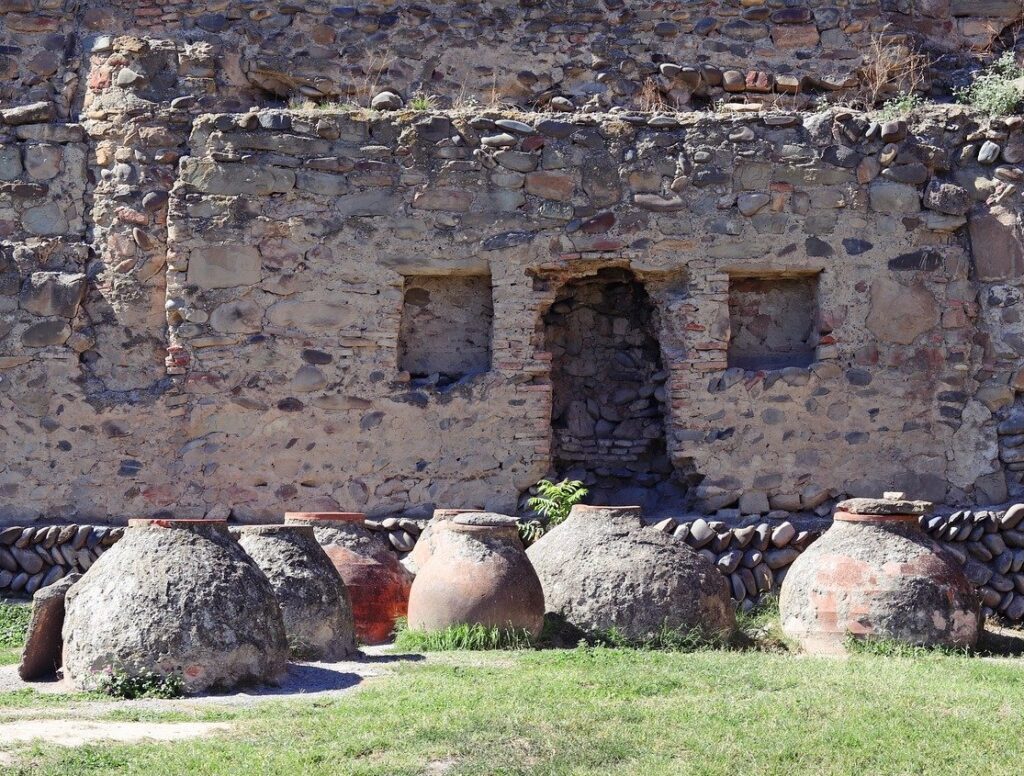Following on from my post on oak, when I touched on the fact different vessels are used for both fermentation and/or maturation of wine, I wanted to look at an entirely different type of vessel – one that dates back to the beginnings of winemaking in fact – the Qvevri. These rather unique vessels hail from Georgia (the country not the US state!). Given that Georgia is considered by many to be the birthplace of wine, perhaps it is no surprise that this ancient wine vessel should originate (and is still widely used) there.
What actually are qvevri? Egg-shaped, earthenware (clay) vessels of varying sizes that are used to ferment, age and store wine. Although they look similar to amphorae, what makes qvevri different (apart from their size and the fact they don’t have handles for transportation) is that these vessels are buried up to their necks underground. Most are coated on the outside with lime (for protection) and on the inside with beeswax (to help control porosity, oxygen ingress and aid the cleaning process).

Why are they buried? It is believed that originally qvevri were not buried, but as demand for the wine grew, and the vessels got larger and larger, they became unstable and prone to collapse – remember they are made of clay! Winemakers decided to bury them to protect them and prevent breakage, in the process discovering that the much cooler temperatures underground gave a natural temperature control to the fermentation process and allowed longer macerations producing more characterful wines.
How is the wine made? The whole berries are lightly crushed and placed in the qvevri – complete with pips, skins and stems (known in Georgia as ‘chacha ’). Fermentation is natural ie indigenous yeast from the skins (without any addition of commercial yeasts) cause the grapes to begin to ferment, in a process that takes several weeks. During this time, the solids rise to the surface and need to be re-submerged and punched down to keep them wet and ensure maximum tannin, aromas and flavour is extracted.
Up until this point the process is the same for red winemaking as for white winemaking, once fermentation is complete however the one difference is that the ‘chacha ’ are removed from the qvevri for red wines but left for the white wines (the reds would be way too tannic and bitter otherwise). After malolactic fermentation (MLF) has taken place, the opening to the qvevri is covered and sealed with clay where it is left for around six months before transferring to a clean qvevri for further storage.
So they are natural wines then? Of sorts yes. They follow traditional winemaking practices and adopt a hands-off approach to winemaking in the vineyard and cellar.
They must be a nightmare to clean? Absolutely, they are too large to move and are buried which makes cleaning difficult. Although coating the inside with beeswax does make the process slightly less arduous, it remains a tricky, time-consuming process. It is important they are scrupulously clean otherwise the presence of bacteria risks ruining the next vintage.
What are the wines like?
Characterful, usually full bodied with plenty of structure and phenolics – and that is for the reds and the whites! When I say white, I should say more like amber, as the colour changes – not so much due to oxidation – but from the extended skin contact. Red wines made in qvevri are less easy to distinguish although they tend to have a tell-tale spicy element.
These are wines that are savoury in nature, quite tannic with less focus on fresh fruit, with more dried fruit. White wines for example tend towards dried apricots and noticeably nutty, herbal and spicy characteristics. They are wines that cry out for food.
If you are interested in trying wine made in a qvevri, M&S used to stock one which I reviewed a while back and can be found here, although I should point out, at time of writing this wine is not currently listed on the M&S website.
Next up “R” is for Rosé.
